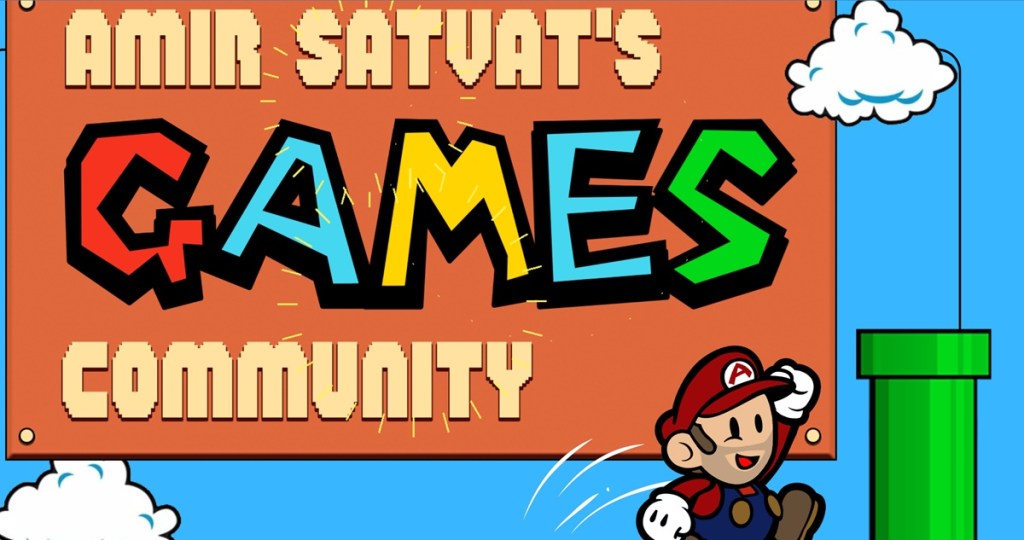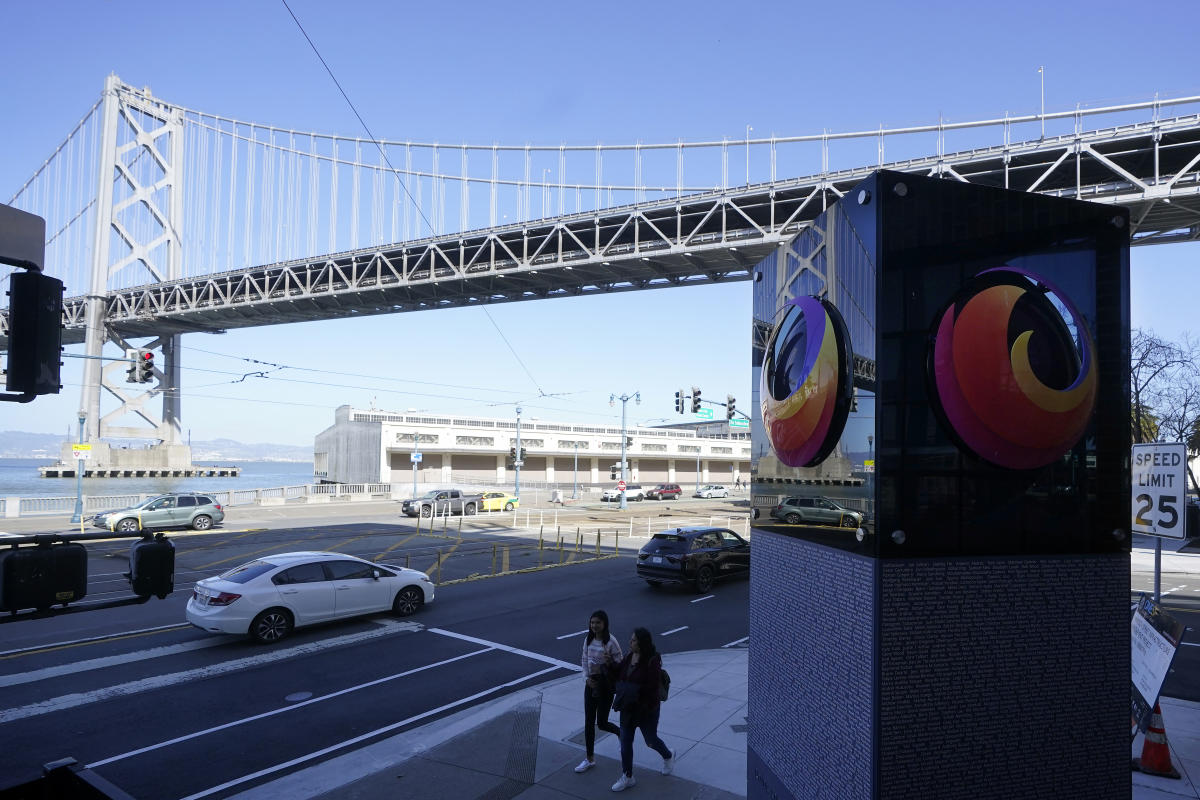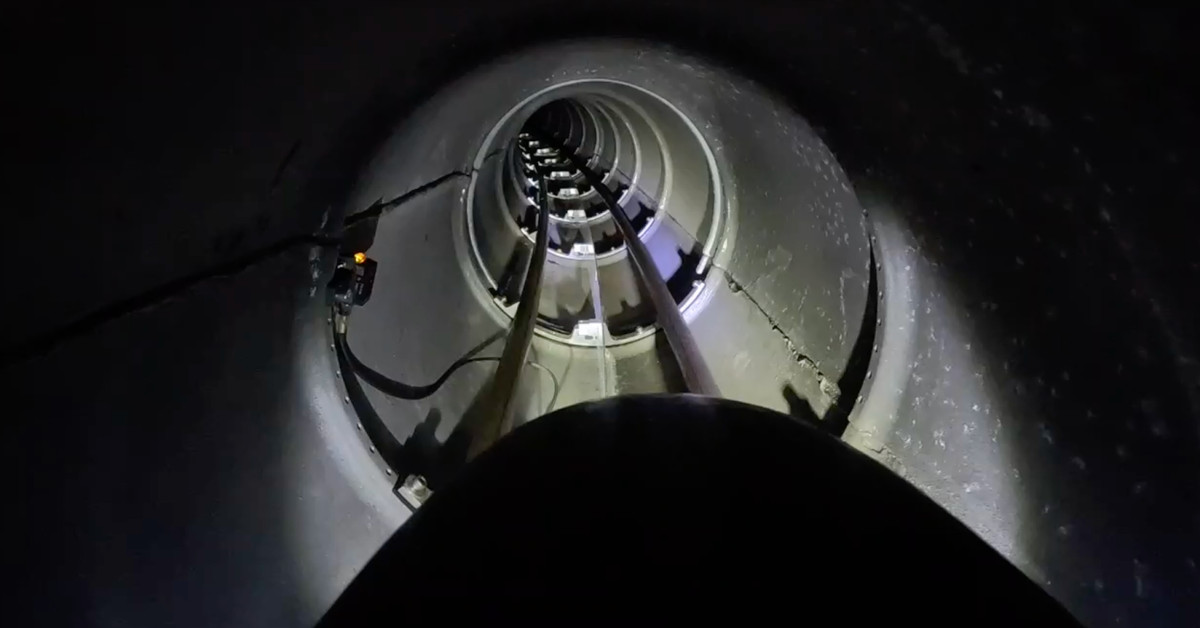About a year ago, I wrote a story with the headline “The hyperloop is dead for real this time,” based on the news that Hyperloop One, one of the biggest companies pursuing Elon Musk’s dream of tube-based, 700mph travel, had shut down.
Technology
For game job seekers, the search often leads outside of gaming

Amir Satvat has been churning out one study after another on the game job market, and his latest one shows that those seeking game jobs are often forced to take jobs outside the industry.
That’s not particularly good news for those job seekers, but the silver lining is that at least many of them find jobs.
In his latest report, there is more data that isn’t quite as bleak as it seemed before. Satvat, who works at Tencent in business development by day, has been providing game job resources by night to those who need it. And from that, he has gained more than 100,000 followers on LinkedIn and turned up a lot of data on game job seekers since November 2022. He now has about 22 months of solid data from that community.
One survey of 1,200-plus game people showed that on average they have 10% chance of finding a games job within 12 months. That’s better than previous data that showed the odds were about 7% to 8%. Those earlier numbers were lower as they only included people who said they were done with their search and are not underemployed or in contract work.
“I don’t release major findings until I’m confident they’re accurate, and with our community’s placements now surpassing 2,800, plus significant data on games job seekers (much of it retroactively collected), I now have a clearer picture of the games job search landscape,” Satvat said in a post.
Many things can affect a job search. In a panel at our GamesBeat Next 2024 event last week, Satvat noted that he didn’t find a job in the game industry until he was 38. Part of the reason was he would only take remote work in Connecticut, where he has family.
By month 22 of a job search, the odds of finding a games job reach 16%. And now, for the first time, Satvat said he has overall job search odds for game job seekers. This includes everyone in his community looking for a games role, not just those laid off.
The data show that many eventually broaden their search, particularly those who never worked in games to begin with. By month 12, the odds of finding any job are 54%. By comparison, the chances of game veterans finding a job in 12 months are one in four. And by month 22, the odds of finding any job for all game job seekers is 71%. This means that expanding your search beyond games significantly improves chances.
A lost generation?

You can improve your chances of finding any job by five times if you look outside of games. Much of the data in the community skews toward younger job seekers and game-focused job seekers. Satvat believes about a third of the 33,000 people laid off in games since 2022 are still job hunting.
At our event last week, Satvat said he worries there is a “lost generation” on both sides of the career arc. At the beginning, many graduating college students aren’t finding jobs in games. And for those 50 and older, ageism means that their odds of finding jobs are at 1% to 2% after a year of searching — just as bad as it is for those with less than three years of experience. It’s worth noting the odds improve for those who use Satvat’s 17 different job resources.
Satvat acknowledged that there are a small (and really unknown) number of people who turn a Roblox user-generated content gig into a full-time job. It may very well be that this has become the ground floor for getting jobs in the game industry.
Satvat noted that about 11,000 people were laid off in games in the first half of 2024, and the second half of the year it slowed down. He expects no more than 4,000 job cuts in the second half of 2024. He sees a crossover, where hiring will exceed firing on a 60-month trailing basis for the first time in years, happening in December.
This is why job placements are well below general unemployment – a big piece is those affected by the 32,000 cuts. We know a third of this population is still looking for work.
At months 16 and beyond, some job seekers may stop reporting due to discouragement and other factors.
“I’m cautious about overinterpreting the rate of increase here, but I believe the general pattern is accurate,” he said.
This data includes all job seekers aiming for roles in games, not only those with prior experience. Thus, not all of the gap between the blue and orange lines reflects an exodus. You can think of this gap as those who wish to work in games but can’t.
Why total job placement is only 71% over 22 months for gamers

In a follow-up post, Satvat said the biggest question he received since the post is why the 22-month total job odds for games jobseekers remain at only 71%.
“This is a complex issue, but I have some initial theories, based on both data and qualitative observations, which I plan to test thoroughly in the coming months,” he said.
He said one factor is that the percentage of games professionals who end up underemployed (in lower-paying roles that don’t cover living expenses), in fractional or contract work, or in other non-full-time roles (which I don’t count as off our still-searching list) has become a much larger part of the picture than people might expect.
There are some other reasons he is considering and will test for. He noted games qualifications, in many instances, are less transferable to other jobs than people think.
He noted that having only 14% of jobs in games as remote and a high geographic concentration – around 75% of North American roles being in just five states or regions – creates significant reemployment challenges.
Many in the community (he repeatedly tests at roughly a 50/50% mix for the members) aren’t open to relocating, and that further complicates reemployment. He also noted that there is ageism and early-career bias, which freezes out both newcomers to the market and those ages over 40 to 50-plus at higher rates than many realize.
“Some people are so passionate about games that, despite what they say, they’re reluctant to seriously pursue non-games roles,” he said.
In repeated surveys of his community and data collection, he said 45% of searchers have been out of work for a year or more. He also said he knows the number of games professionals laid off from 2022 through 2024 year to date, thanks to good reporting.
Based on the repeated community polls with thousands of responses, he knows that 30% to 40% of all laid-off games professionals were still looking for work as of two to three months ago.
And in a third post, Satvat asaid that, beyond just the odds of finding a job in games, he looked at the likelihood of securing any type of job for games job seekers.
Instead of only offering a “point-in-time” statistic for finding a job within 12 months, he attempted, for the first time, to chart the monthly odds offinding a games job, a non-games job, or any job over a span of one to 22 months.

The surprising takeaway that has gotten the most attention was that, over a 22-month period, the odds of games jobseekers finding any job was just 71%. He created some scenarios in a hypothetical chart.
He noted the figures below aren’t actual data points but serve as hypothetical examples. These scenarios reflect the kind of data he is continuing to refine, with the goal of making it more precise.
Imagine, hypothetically, that 15,000 people secure games jobs in 22 months. In healthier times, 25% of job seekers find roles in games, before recent layoffs.
With 60,000 games jobseekers, 15,000 find games jobs, while the other 45,000 need to find work outside of games. In more stable times, Satvat assumed 95% of people achieve full employment by month 22 – this means 42,750 find non-games roles, leaving 2,250 unfulfilled. In this scenario, the games industry and adjacent fields are absorbing enough talent to minimize slack.
Now consider a more stressed scenario: imagine an influx of 33,750 more jobseekers into the pool over three years – which is not hypothetical at all (some sources estimate 32,000, but Satvat believes it’s closer to 33,750).
If the same 15,000 games roles are available, the placement rate in games drops to 16%, leaving 78,750 games jobseekers. If we assume a hypothetical 71% of jobseekers find employment in 22 months, then 55,913 people secure non-games jobs, with 22,838 remaining without a role.
Over time, as job seekers become more flexible or shift markets, this “slack” could diminish, and one would see a return to the healthier scenario on top.
Again, these figures are illustrative, but they highlight why 71% is not surprising given the shock to the system. In normal times, the games placement rate over 22 months could be much higher.
Historically, the games industry averaged 1,000 to 2,000 layoffs a year, not 10,000-plus, so until recent years, the first scenario was more typical.
“I believe, and hope, that things will return to that norm sooner rather than later,” he said.
Source link
Technology
Mozilla Foundation cuts 30 percent of its staff

The Mozilla Foundation has made steep cuts to its team. The 30 percent staff cuts will completely eliminate the nonprofit’s advocacy and global programs divisions, according to an internal email sent by Mozilla Foundation Executive Director Nabiha Syed. reported on the news, and Mozilla confirmed the cuts in a statement to the publication.
“The Mozilla Foundation is reorganizing teams to increase agility and impact as we accelerate our work to ensure a more open and equitable technical future for us all,” the statement read. “That unfortunately means ending some of the work we have historically pursued and eliminating associated roles to bring more focus going forward.” We’ve reached out to the Foundation and will update if we receive any additional comment.
The Mozilla Foundation is a nonprofit arm under the bigger Mozilla umbrella; Mozilla Corporation is the arm responsible for the Firefox browser. In February, Mozilla that about 60 workers would be laid off, primarily on the product development team.
Developing…
Technology
Nodal connects hopeful parents with surrogates as reproductive freedom hangs in limbo

Many people who want to have children can’t, or shouldn’t, carry a pregnancy for a variety of reasons. Gestational surrogacy can be a great option for those individuals — if they can endure the lengthy wait times and afford to pay for the costly service. New York-based Nodal looks to make the process less expensive, more transparent, and faster.
Nodal is a marketplace for prospective parents to get matched with vetted surrogates. Nodal founder and CEO Dr. Brian Levine told TechCrunch that his company wants to fix the industry’s supply-and-demand problems.

Nodal takes the same technology-driven approach as life insurance companies to vet potential surrogates, Levine said, which speeds up the process and allows for more surrogates to be available. The marketplace approach also provides transparency for parents to have more control over which surrogate they work with. Nodal also cuts out middleman costs and works with fertility benefit companies like Carrot, Maven, and Progyny to lower the costs for prospective parents.
Levine said Nodal is designed to help lower costs, even for people who are paying out of pocket. Users pay a $500 monthly fee until they find a match. Facilitating the match is $15,000, and those monthly payments chip away at that total. If users want Nodal to serve as a case manager, those services start at an additional $10,000. While still expensive, Levine said prior to launching Nodal, his patients were spending up to $180,000 for all of this.
“We have saved our intended parents over $5 million in fees,” Levine said. “We have saved them over a century of waiting time because we are running 45 days on average to match. The average in America is nine to 18 months. You can have a baby on the Nodal platform before you get off the waitlist at a Nodal competitor.”
Levine knows the space well as a still-practicing physician with a speciality in obstetrics and gynecology. He got the idea for Nodal back in 2021 when New York became the 48th state to legalize gestational surrogacy; only Louisiana and Nebraska still don’t allow the practice. While Levine originally was excited that the ruling would open up opportunity for his patients in the state, that’s not exactly what happened.
“I was totally jazzed by this whole thing,” Levine said. “Very quickly I realized that it was truly a broken system. The cost had gone from $75,000 to $150,000 overnight. The reason it got so expensive is because supply and demand took hold. We are the largest fertility market in America; it literally drove up the price all over the country.”
The price increases weren’t benefiting the surrogates but rather padding the pockets of the matching agencies. Levine thought there must be a way to make this process better for both sides using technology, which led him to work on Nodal; it’s named after the protein that must be present in the uterus to be able to carry a baby.
The product officially launched in September 2022, is available in all 50 states, and has since matched 108 hopeful parents with a surrogate. The average clinic matches 25 a year, Levine said.
Now the startup is announcing a $4 million seed extension round led by NFX that gives the company a $15 million post-money valuation. The round also included Amplo, Liquid 2, and Myelin VC, among others. The company has raised $8.7 million in total.
Levine said that Nodal wanted to hit $10 million in annual recurring revenue before it raised their Series A round. He added that they didn’t really need to raise this round but thought it made sense as a reproductive health company amid the uncertainty surrounding the results of Tuesday’s U.S. presidential election.
“I didn’t know how this election was going to sway,” he said. “It would be myopic to not raise for women’s healthcare before the world potential changes into what could be a very challenging time for reproductive health.”
The company will invest the funds entirely into the technology, Levine said. Nodal wants to increase its partnerships with fertility clinics, too, so that more people can easily get referred to Nodal when they are looking to build a family.
Despite demand, there seemingly aren’t any direct competitors for Nodal beyond traditional surrogacy agencies, which are still just scratching the surface. Levine estimated that the current system fulfills less than 10% of overall demand for surrogates, which means Nodal can grab substantial market share. But it has a long way to go.
“From a big picture perspective, what I hope people take away is this is a company that is completely focused on transparency, speed, and safety,” Levine said. “It’s unfortunate that the industry has gotten where it is today. It’s opaque, analog, and clunky. We recognize that we have the opportunity to really help people.”
Technology
The hyperloop lives on as a 1/12th scale model in Switzerland

Well, I stand corrected. The hyperloop, in fact, lives on — as a 1/12th scale model in Switzerland.
Sure, this isn’t exactly the full realization of Musk’s 2013 white paper, in which he theorized that aerodynamic aluminum capsules filled with passengers or cargo could be propelled through a nearly airless tube at speeds of up to 760mph. These tubes, either raised on pylons or sunk beneath the earth, could be built either within or between cities. Musk called it a “fifth mode of transportation” and argued it could help change the way we live, work, trade, and travel.
The idea is being put to the test in Lausanne, Switzerland, where a 120-meter circular test track is being operated by a team that includes the Federal Institute of Technology Lausanne (EPFL), the School of Business and Engineering Vaud (HEIG-VD), and Swisspod Technologies. This week, the group announced that it had conducted “the longest” hyperloop test of its kind: traveling 11.8 km (7.3 miles) at a speed of 40.7km/h (25.3mph).
The circular test track has a circumference of 125.6 meters (412 feet) and a diameter of 40 centimeters (15.7 inches). It sounds modest, but the group claims that in a full-scale system, their test “directly translates” to a journey of 141.6 km (88 miles), which is about the distance between Geneva and Bern, or San Francisco to Sacramento, and speeds of up to 488.2 km/h (303.4mph).
The project is called LIMITLESS, which stands for Linear Induction Motor Drive for Traction and Levitation in Sustainable Hyperloop Systems. During the test, the team “monitored the performance of vital subsystems,” including propulsion, communication infrastructure, power electronics, and thermal management. They assessed “energy consumption, thrust variations, [linear induction motor] response, and control during acceleration, cruising, coasting, and braking scenarios.”
Of course, a 1/12th-scale circular test track is hardly a sign that the hyperloop is alive and well. Most of the startups and companies pursuing a full-scale hyperloop have shut down, victims of financial mismanagement, as well as infrastructure and regulatory hurdles. Critics said that while the hyperloop may be technically feasible, it still only amounts to vaporware. It’s been called a “utopian vision” that would be financially impossible to achieve.
But the Swiss team is undeterred, promising to conduct a battery of future tests to further validate the system. Swisspod CEO Denis Tudor said the group plans to test its first freight product soon, and is currently building a larger test track in the US.
“This is a key step toward making hyperloop for passengers a reality and changing how we connect, work, and live,” he said.
That would be a feat unto itself, considering that no full-scale hyperloops exist anywhere in the world. Musk’s test tunnel in California is gone. The man himself has become more enamored with campaigning for Donald Trump than solving the problem of car traffic.
The Boring Company, Musk’s tunneling operation, is still digging underground passageways in Las Vegas — but for Teslas, not hyperloops. The future, it would seem, is nearly the same as the present.
Technology
Nvidia’s RTX 5000 series announcement could be closer than you think as reliable leaker suggests reveal is coming soon


- A new leak hints at an RTX 5000 series reveal sooner than expected
- Previous leaks showcased the possible specifications of the RTX 5090
- The RTX 5090’s leaked price could be accurate based on rumored specs
There have been a plethora of rumors and leaks regarding Nvidia’s upcoming GeForce RTX 5000 series reveal, but according to a reliable leaker it could be much closer than anticipated.
Spotted by Wccftech, Kopite7kimi on X, hinted at Team Green’s inevitable announcement in a post that states ‘We will meet GeForce of Blackwell soon’ – the user accurately revealed some specifications of the RTX 4080 (and the RTX 5090 which isn’t officially confirmed), which suggests an announcement or teaser could be upon us before the end of the year.
We know Nvidia’s CEO Jensen Huang will be delivering a CES 2025 keynote, which is a big indication of the GPU series reveal – this could mean Kopite7kimi is referencing the CES 2025 event or an incoming teaser from Team Green. Regardless, we won’t be waiting very long to see the RTX 5000 series unveiled, with CES coming in January.
Is the ‘leaked’ price of the RTX 5090 legitimate?
There’s no official confirmation from Nvidia on any of the RTX 5000 GPUs nor their specifications or pricing, but if the leaked specs for the flagship GPU (the rumored RTX 5090) are anything to go by, we could indeed see a $2,500 price tag. Considering the pricing behind the RTX 4090 ($1,599 / £1,499 / AU$2,959 at MSRP) at launch, it isn’t much of a surprise to see rumors of a major price increase.
The RTX 5090 is rumored to utilize 32GB of VRAM, a significant leap from its predecessor’s 24GB – Team Green’s new Blackwell architecture will see the new GPUs driven by AI, with DLSS and Frame Generation expected to play a bigger part with this release. If Nvidia makes DLSS 3’s successor exclusive to the new GPU series (which we hope it won’t), then you can expect the demand to skyrocket.
Scalping with Nvidia’s GPUs has been a significant issue, especially during COVID-19 – the rumored $2,500 price has the potential to make this much worse, but we hope this isn’t the case once the new range launches.
You may like this…
Technology
Another annoying bug is spoiling the fun in Windows 11 24H2


The latest big update to Windows 11 has already caused its fair share of headaches. This time the trouble is with File Explorer. A new bug makes it difficult to open the File Explorer app as it makes the menu appear outside the screen, Windows Latest reports.
The latest bug impacts the “See more” menu, making it practically impossible to access when you select the ellipses. Instead, it only shows you a few of the available options. This error usually appears when you use File Explorer in full screen. When you’re able to see all the options in the “See more” menu, you’ll see options such as:
- Connect to a media server
- Add a network location
- Map network drive
- Select all
- Select none
- Invert selection
- Properties
- Options
Some users have reported this incomplete view regardless of the viewing mode. In theory, the menu is supposed to appear below the button for easy access to the options. But this bug is making various options inaccessible. To view all the options, ensure that the window is small enough, leaving space for the menu options.
The good news is that Microsoft is aware of the bug and will release a fix in a future cumulative update. There is no official confirmation as to when we might see this update, but it’s nice to know that it’s on its way.
This is far from the first problem Windows 11 24H2 users have faced. One of the most common problems is the update crashing PCs, causing slowdowns and blue screens of death (BSOD).
Windows 11 24H2 is off to a bumpy start, so much so that it forced Microsoft to stop the update on PCs such as Asus and configurations for software like Safe Exam Browser, Voicemeter, and older versions of Easy Anti-Cheat that are used mainly by PC gamers.
Technology
Samsung Galaxy Buds FE drop to $50, an all-time low

Right now you can pick up Samsung’s stellar Galaxy Buds FE true wireless earbuds for $59.99, and that’s a very good price for a pair of true wireless earbuds that are as good as these ones are. Even at their full retail price of $99.99, the Galaxy Buds FE are a pretty good value. So it’s always going to be an incredible value when they’re priced this low.
This is the lowest we’ve ever seen the Galaxy Buds FE cost and it’s also an all-time low price based on price tracking data from Camel Camel Camel.

The Samsung Galaxy Buds FE are Samsung’s budget option of the Galaxy Buds and yet, they come with a lot of the same quality features. During our testing time we found that the earbuds had great battery life and a range of decent EQ options. They also come with balanced sound for an enjoyable, well-rounded listening experience no matter what type of music it is.
These also come with Active Noise Cancellation and that’s probably our favorite feature. Have you ever been on public transit, or on an airplane and you’re surrounded by noisy people? If you had these earbuds with ANC that wouldn’t be an issue. You could just pop them in, turn the ANC on, and block everyone else out. It’s excellent. And it makes a big difference in travel. I personally like to use it while I’m out shopping at the grocery store or other stores and block out the ambient noise of the store and other shoppers.
These come in two colors, Graphite and White, and both colors are on sale for the $59.99 price point.
-

 Science & Environment2 months ago
Science & Environment2 months agoHow to unsnarl a tangle of threads, according to physics
-

 Technology1 month ago
Technology1 month agoIs sharing your smartphone PIN part of a healthy relationship?
-

 Science & Environment2 months ago
Science & Environment2 months ago‘Running of the bulls’ festival crowds move like charged particles
-

 Science & Environment2 months ago
Science & Environment2 months agoHyperelastic gel is one of the stretchiest materials known to science
-

 Technology2 months ago
Technology2 months agoWould-be reality TV contestants ‘not looking real’
-

 Science & Environment1 month ago
Science & Environment1 month agoX-rays reveal half-billion-year-old insect ancestor
-

 Science & Environment2 months ago
Science & Environment2 months agoMaxwell’s demon charges quantum batteries inside of a quantum computer
-

 Money1 month ago
Money1 month agoWetherspoons issues update on closures – see the full list of five still at risk and 26 gone for good
-

 Science & Environment2 months ago
Science & Environment2 months agoSunlight-trapping device can generate temperatures over 1000°C
-

 Science & Environment2 months ago
Science & Environment2 months agoPhysicists have worked out how to melt any material
-

 Sport1 month ago
Sport1 month agoAaron Ramsdale: Southampton goalkeeper left Arsenal for more game time
-

 Technology1 month ago
Technology1 month agoGmail gets redesigned summary cards with more data & features
-

 Football1 month ago
Football1 month agoRangers & Celtic ready for first SWPL derby showdown
-

 MMA1 month ago
MMA1 month ago‘Dirt decision’: Conor McGregor, pros react to Jose Aldo’s razor-thin loss at UFC 307
-

 Science & Environment2 months ago
Science & Environment2 months agoLaser helps turn an electron into a coil of mass and charge
-

 Technology1 month ago
Technology1 month agoUkraine is using AI to manage the removal of Russian landmines
-

 News1 month ago
News1 month agoWoman who died of cancer ‘was misdiagnosed on phone call with GP’
-

 Sport1 month ago
Sport1 month agoBoxing: World champion Nick Ball set for Liverpool homecoming against Ronny Rios
-

 Technology1 month ago
Technology1 month agoEpic Games CEO Tim Sweeney renews blast at ‘gatekeeper’ platform owners
-

 Science & Environment2 months ago
Science & Environment2 months agoA new kind of experiment at the Large Hadron Collider could unravel quantum reality
-

 Technology1 month ago
Technology1 month agoRussia is building ground-based kamikaze robots out of old hoverboards
-

 Technology1 month ago
Technology1 month agoSamsung Passkeys will work with Samsung’s smart home devices
-

 MMA1 month ago
MMA1 month agoDana White’s Contender Series 74 recap, analysis, winner grades
-

 News1 month ago
News1 month ago‘Blacks for Trump’ and Pennsylvania progressives play for undecided voters
-

 Science & Environment2 months ago
Science & Environment2 months agoQuantum ‘supersolid’ matter stirred using magnets
-

 Science & Environment2 months ago
Science & Environment2 months agoLiquid crystals could improve quantum communication devices
-
Business1 month ago
how UniCredit built its Commerzbank stake
-

 Technology1 month ago
Technology1 month agoMicrosoft just dropped Drasi, and it could change how we handle big data
-

 MMA4 weeks ago
MMA4 weeks ago‘Uncrowned queen’ Kayla Harrison tastes blood, wants UFC title run
-

 News1 month ago
News1 month agoNavigating the News Void: Opportunities for Revitalization
-

 Science & Environment2 months ago
Science & Environment2 months agoWhy this is a golden age for life to thrive across the universe
-

 News1 month ago
News1 month agoRwanda restricts funeral sizes following outbreak
-

 Technology1 month ago
Technology1 month agoCheck, Remote, and Gusto discuss the future of work at Disrupt 2024
-

 Sport1 month ago
Sport1 month ago2024 ICC Women’s T20 World Cup: Pakistan beat Sri Lanka
-

 TV1 month ago
TV1 month agoসারাদেশে দিনব্যাপী বৃষ্টির পূর্বাভাস; সমুদ্রবন্দরে ৩ নম্বর সংকেত | Weather Today | Jamuna TV
-

 MMA1 month ago
MMA1 month agoPereira vs. Rountree prediction: Champ chases legend status
-

 News1 month ago
News1 month agoMassive blasts in Beirut after renewed Israeli air strikes
-

 Entertainment1 month ago
Entertainment1 month agoBruce Springsteen endorses Harris, calls Trump “most dangerous candidate for president in my lifetime”
-

 Technology1 month ago
Technology1 month agoWhy Machines Learn: A clever primer makes sense of what makes AI possible
-

 Technology1 month ago
Technology1 month agoMicrophone made of atom-thick graphene could be used in smartphones
-

 Business1 month ago
Business1 month agoWater companies ‘failing to address customers’ concerns’
-

 News1 month ago
News1 month agoCornell is about to deport a student over Palestine activism
-

 Business1 month ago
Business1 month agoWhen to tip and when not to tip
-

 Sport1 month ago
Sport1 month agoWXV1: Canada 21-8 Ireland – Hosts make it two wins from two
-

 News2 months ago
News2 months ago▶️ Hamas in the West Bank: Rising Support and Deadly Attacks You Might Not Know About
-

 Science & Environment2 months ago
Science & Environment2 months agoQuantum forces used to automatically assemble tiny device
-

 Science & Environment2 months ago
Science & Environment2 months agoITER: Is the world’s biggest fusion experiment dead after new delay to 2035?
-

 MMA1 month ago
MMA1 month agoKayla Harrison gets involved in nasty war of words with Julianna Pena and Ketlen Vieira
-

 Football1 month ago
Football1 month ago'Rangers outclassed and outplayed as Hearts stop rot'
-

 News1 month ago
News1 month agoHull KR 10-8 Warrington Wolves – Robins reach first Super League Grand Final
-
Business1 month ago
Top shale boss says US ‘unusually vulnerable’ to Middle East oil shock
-

 Technology1 month ago
Technology1 month agoSingleStore’s BryteFlow acquisition targets data integration
-

 Sport1 month ago
Sport1 month agoChina Open: Carlos Alcaraz recovers to beat Jannik Sinner in dramatic final
-

 Football1 month ago
Football1 month agoWhy does Prince William support Aston Villa?
-

 News1 month ago
News1 month ago▶ Hamas Spent $1B on Tunnels Instead of Investing in a Future for Gaza’s People
-

 Science & Environment2 months ago
Science & Environment2 months agoNuclear fusion experiment overcomes two key operating hurdles
-

 Science & Environment2 months ago
Science & Environment2 months agoA slight curve helps rocks make the biggest splash
-

 Technology2 months ago
Technology2 months agoMeta has a major opportunity to win the AI hardware race
-

 Womens Workouts1 month ago
Womens Workouts1 month ago3 Day Full Body Women’s Dumbbell Only Workout
-

 Technology1 month ago
Technology1 month agoMusk faces SEC questions over X takeover
-

 Sport1 month ago
Sport1 month agoPremiership Women’s Rugby: Exeter Chiefs boss unhappy with WXV clash
-

 Sport1 month ago
Sport1 month agoShanghai Masters: Jannik Sinner and Carlos Alcaraz win openers
-

 Sport1 month ago
Sport1 month agoCoco Gauff stages superb comeback to reach China Open final
-
Business1 month ago
Bank of England warns of ‘future stress’ from hedge fund bets against US Treasuries
-

 Technology1 month ago
Technology1 month agoLG C4 OLED smart TVs hit record-low prices ahead of Prime Day
-

 MMA1 month ago
MMA1 month ago‘I was fighting on automatic pilot’ at UFC 306
-

 Technology1 month ago
Technology1 month agoUniversity examiners fail to spot ChatGPT answers in real-world test
-

 News1 month ago
News1 month agoGerman Car Company Declares Bankruptcy – 200 Employees Lose Their Jobs
-

 Sport1 month ago
Sport1 month agoSturm Graz: How Austrians ended Red Bull’s title dominance
-

 Sport1 month ago
Sport1 month agoWales fall to second loss of WXV against Italy
-
Business1 month ago
DoJ accuses Donald Trump of ‘private criminal effort’ to overturn 2020 election
-
Business1 month ago
Sterling slides after Bailey says BoE could be ‘a bit more aggressive’ on rates
-

 TV1 month ago
TV1 month agoTV Patrol Express September 26, 2024
-

 Money4 weeks ago
Money4 weeks agoTiny clue on edge of £1 coin that makes it worth 2500 times its face value – do you have one lurking in your change?
-

 Science & Environment2 months ago
Science & Environment2 months agoTime travel sci-fi novel is a rip-roaringly good thought experiment
-

 MMA1 month ago
MMA1 month agoPennington vs. Peña pick: Can ex-champ recapture title?
-

 MMA1 month ago
MMA1 month agoKetlen Vieira vs. Kayla Harrison pick, start time, odds: UFC 307
-

 Technology1 month ago
Technology1 month agoThe best shows on Max (formerly HBO Max) right now
-

 Technology1 month ago
Technology1 month agoIf you’ve ever considered smart glasses, this Amazon deal is for you
-

 Technology1 month ago
Technology1 month agoJ.B. Hunt and UP.Labs launch venture lab to build logistics startups
-
Travel1 month ago
World of Hyatt welcomes iconic lifestyle brand in latest partnership
-

 Technology1 month ago
Technology1 month agoQuoroom acquires Investory to scale up its capital-raising platform for startups
-
Business1 month ago
The search for Japan’s ‘lost’ art
-

 Sport1 month ago
Sport1 month agoNew Zealand v England in WXV: Black Ferns not ‘invincible’ before game
-

 Sport1 month ago
Sport1 month agoMan City ask for Premier League season to be DELAYED as Pep Guardiola escalates fixture pile-up row
-

 News2 months ago
News2 months ago▶️ Media Bias: How They Spin Attack on Hezbollah and Ignore the Reality
-

 Science & Environment2 months ago
Science & Environment2 months agoNerve fibres in the brain could generate quantum entanglement
-

 Technology1 month ago
Technology1 month agoAmazon’s Ring just doubled the price of its alarm monitoring service for grandfathered customers
-

 News1 month ago
News1 month agoTrump returns to Pennsylvania for rally at site of assassination attempt
-

 Technology4 weeks ago
Technology4 weeks agoThe FBI secretly created an Ethereum token to investigate crypto fraud
-

 Science & Environment2 months ago
Science & Environment2 months agoHow to wrap your mind around the real multiverse
-

 Business1 month ago
Business1 month agoStocks Tumble in Japan After Party’s Election of New Prime Minister
-

 MMA1 month ago
MMA1 month agoHow to watch Salt Lake City title fights, lineup, odds, more
-

 Technology1 month ago
Technology1 month agoTexas is suing TikTok for allegedly violating its new child privacy law
-

 Technology1 month ago
Technology1 month agoOpenAI secured more billions, but there’s still capital left for other startups
-
Business1 month ago
‘Let’s be more normal’ — and rival Tory strategies
-

 News1 month ago
News1 month agoHarry vs Sun publisher: ‘Two obdurate but well-resourced armies’
-

 News1 month ago
News1 month agoFamily plans to honor hurricane victim using logs from fallen tree that killed him
-

 Money1 month ago
Money1 month agoPub selling Britain’s ‘CHEAPEST’ pints for just £2.60 – but you’ll have to follow super-strict rules to get in
-

 Sport1 month ago
Sport1 month agoURC: Munster 23-0 Ospreys – hosts enjoy second win of season

You must be logged in to post a comment Login